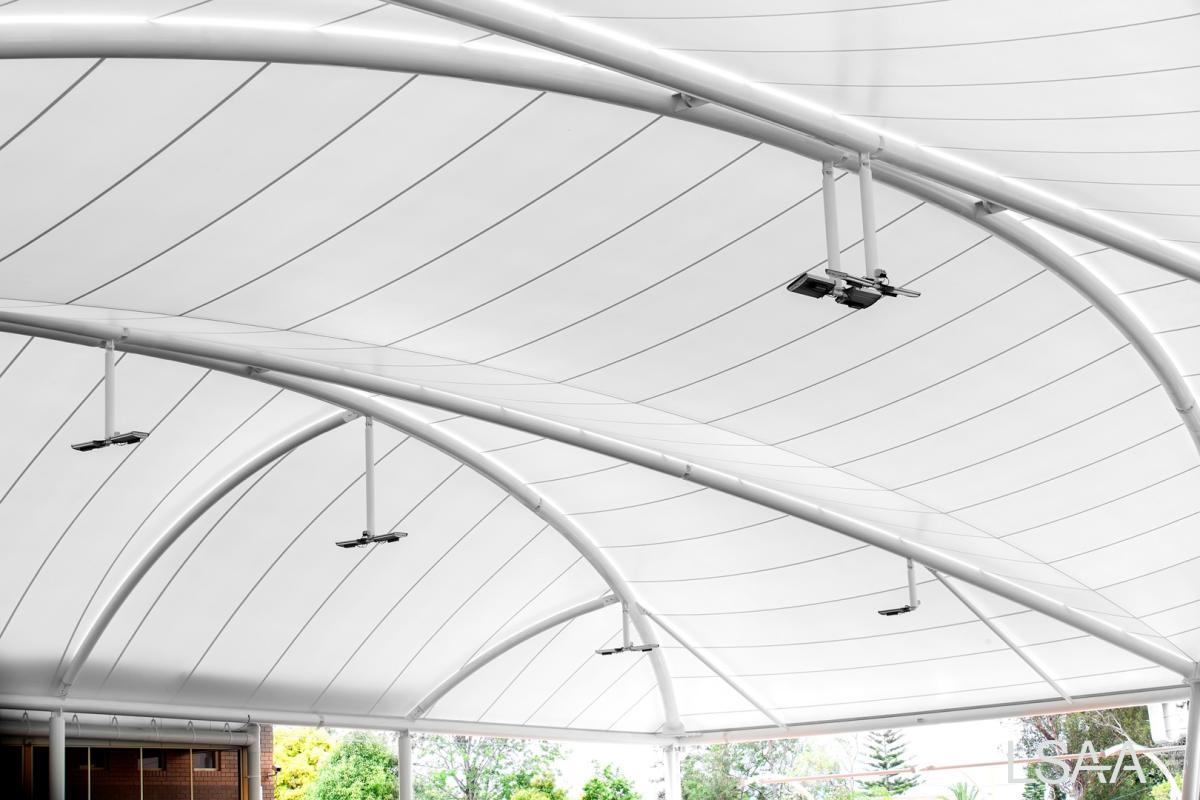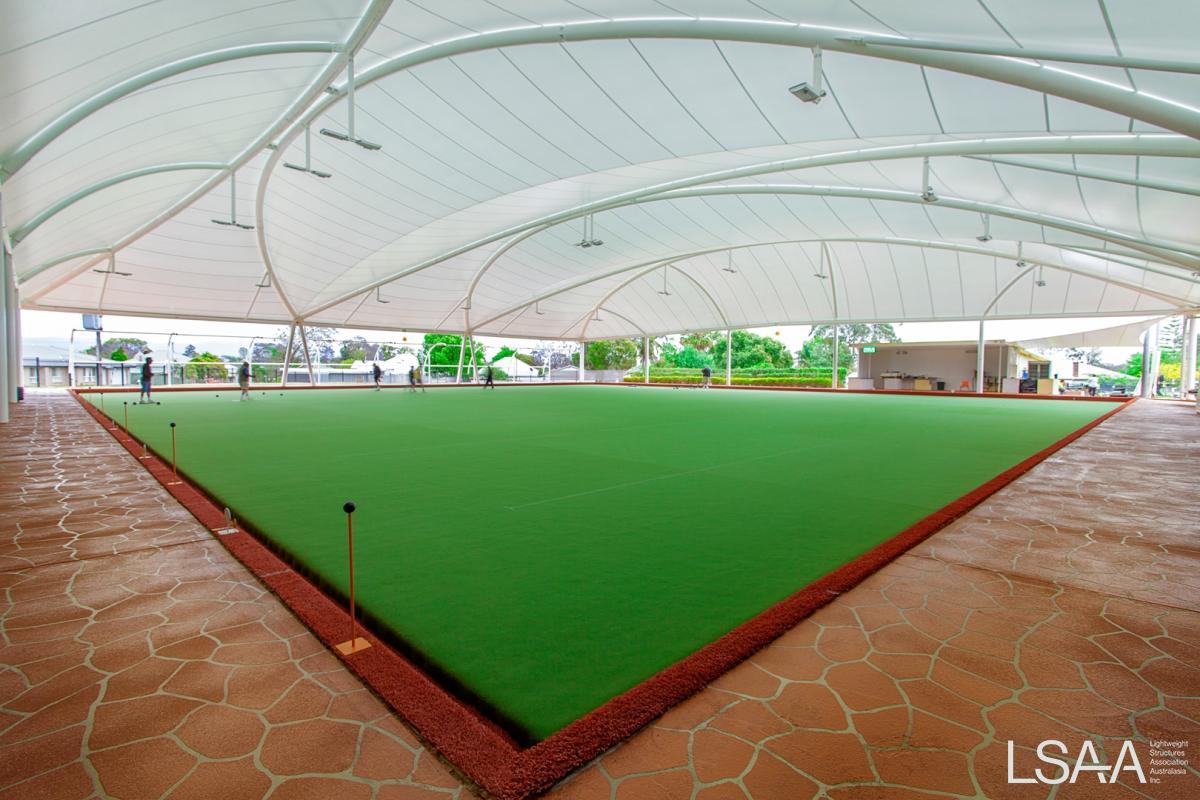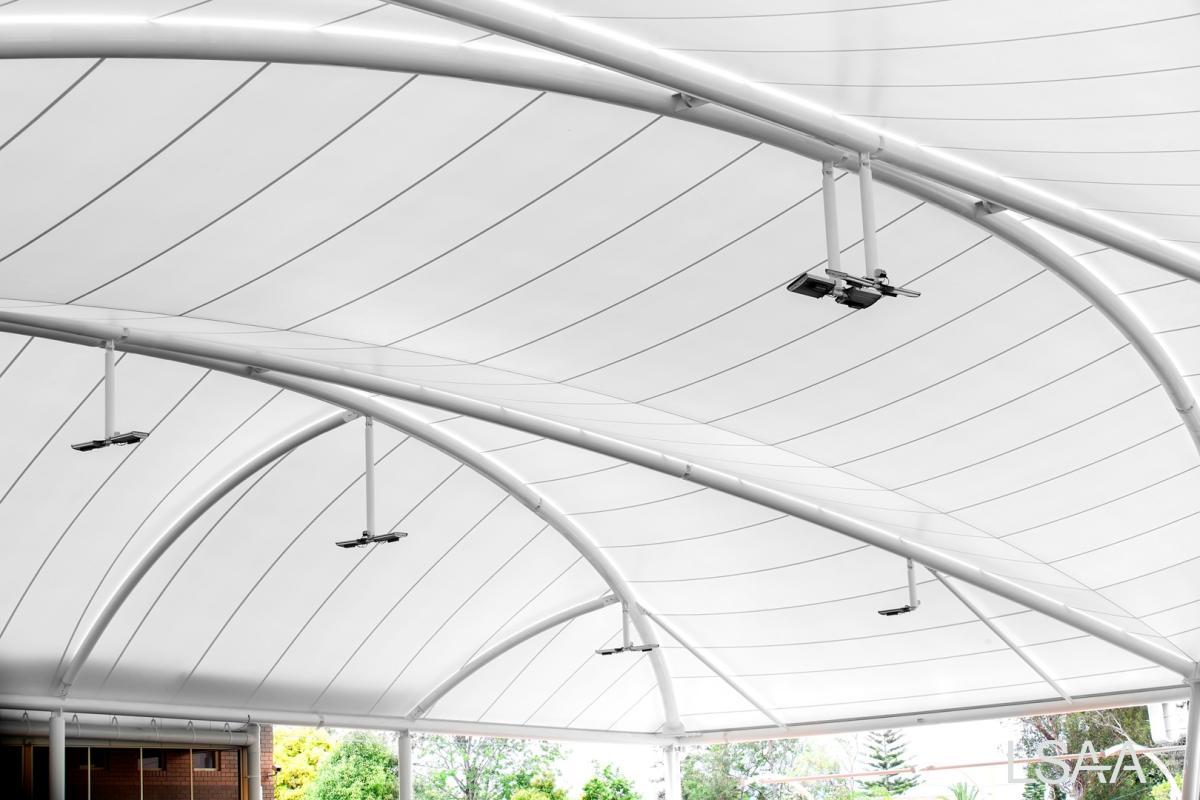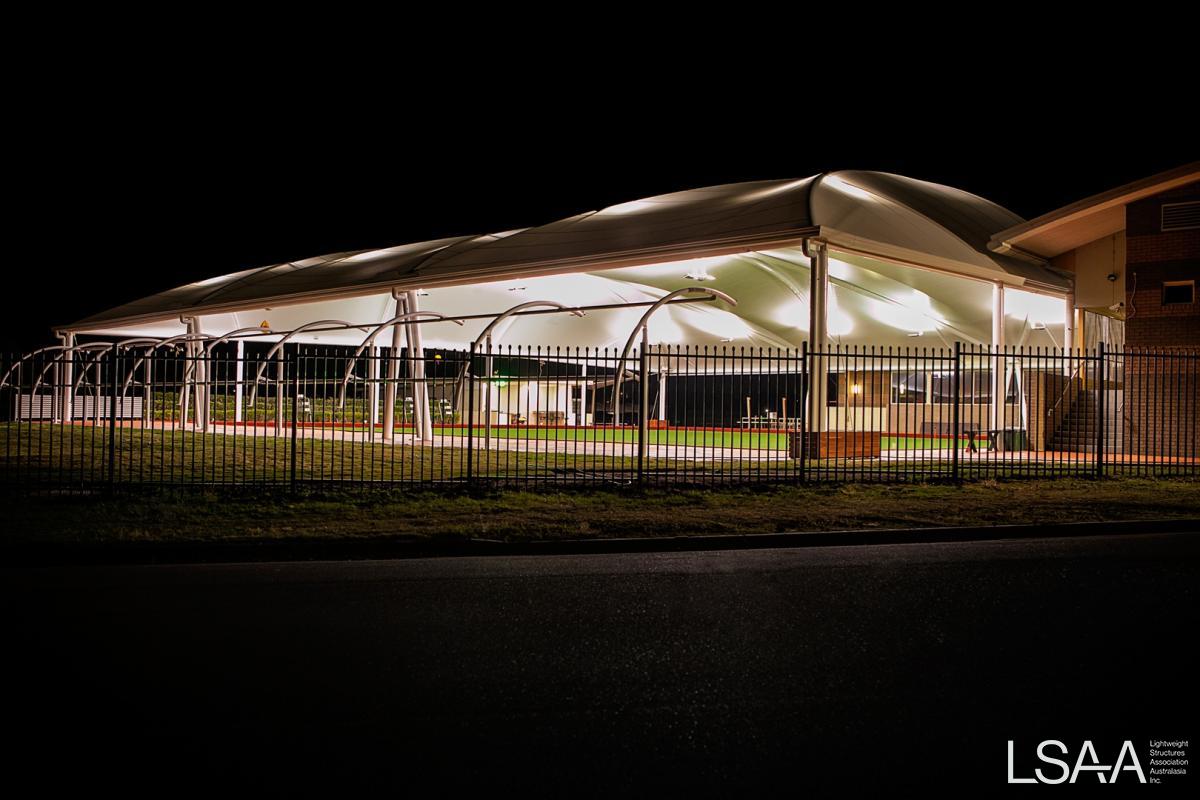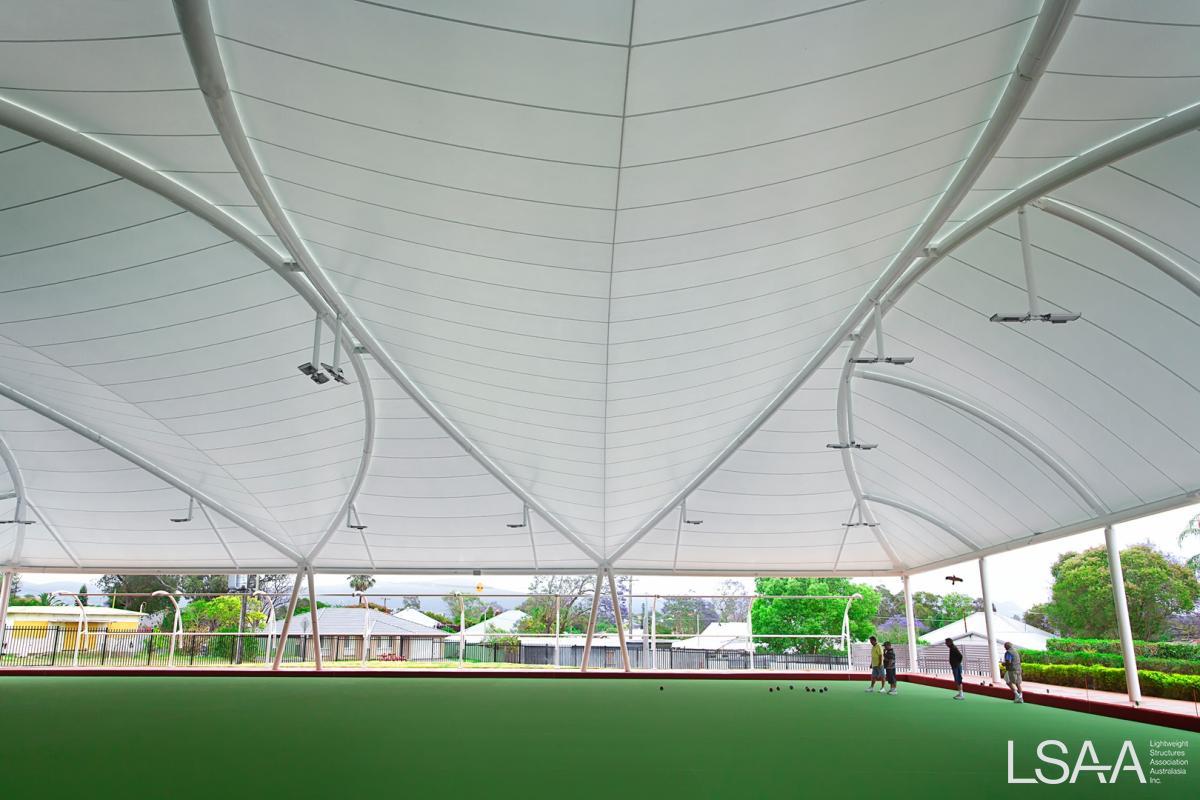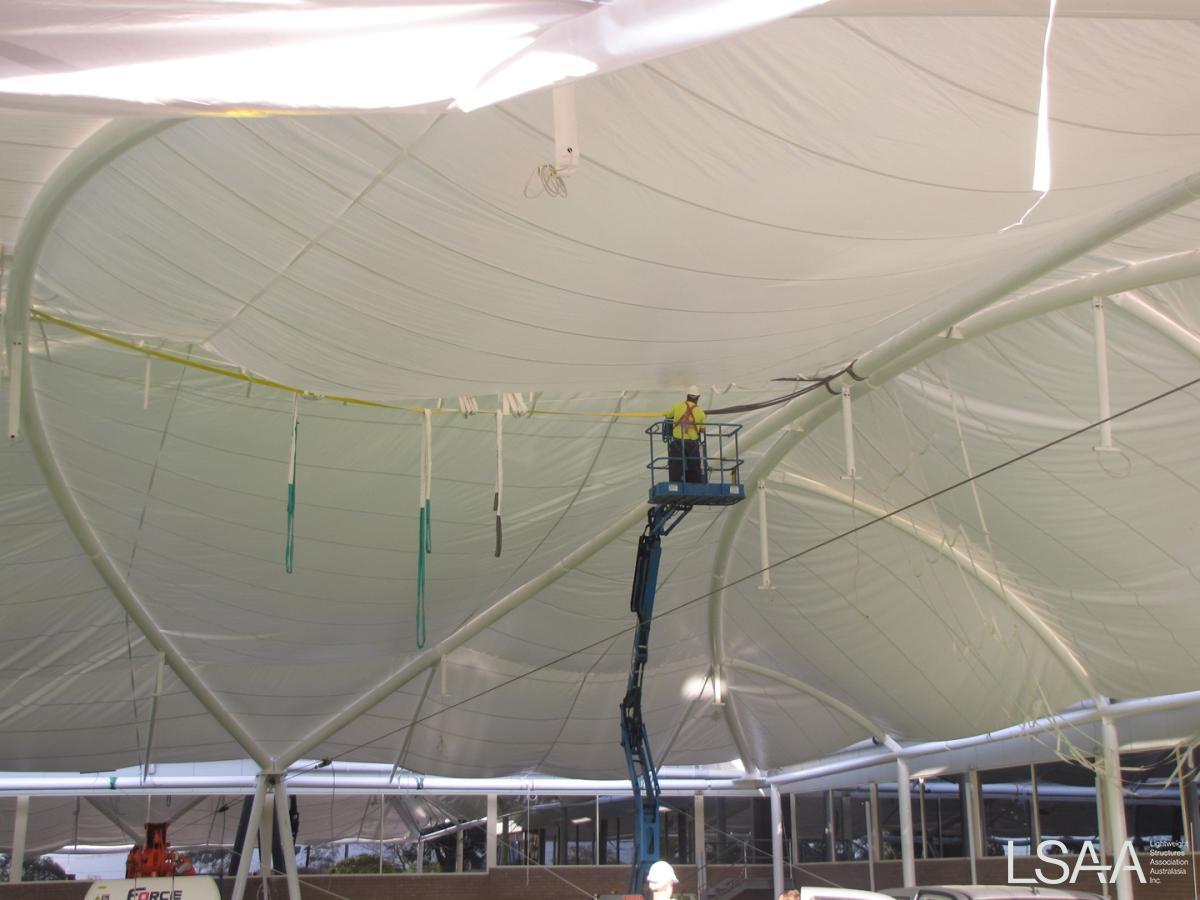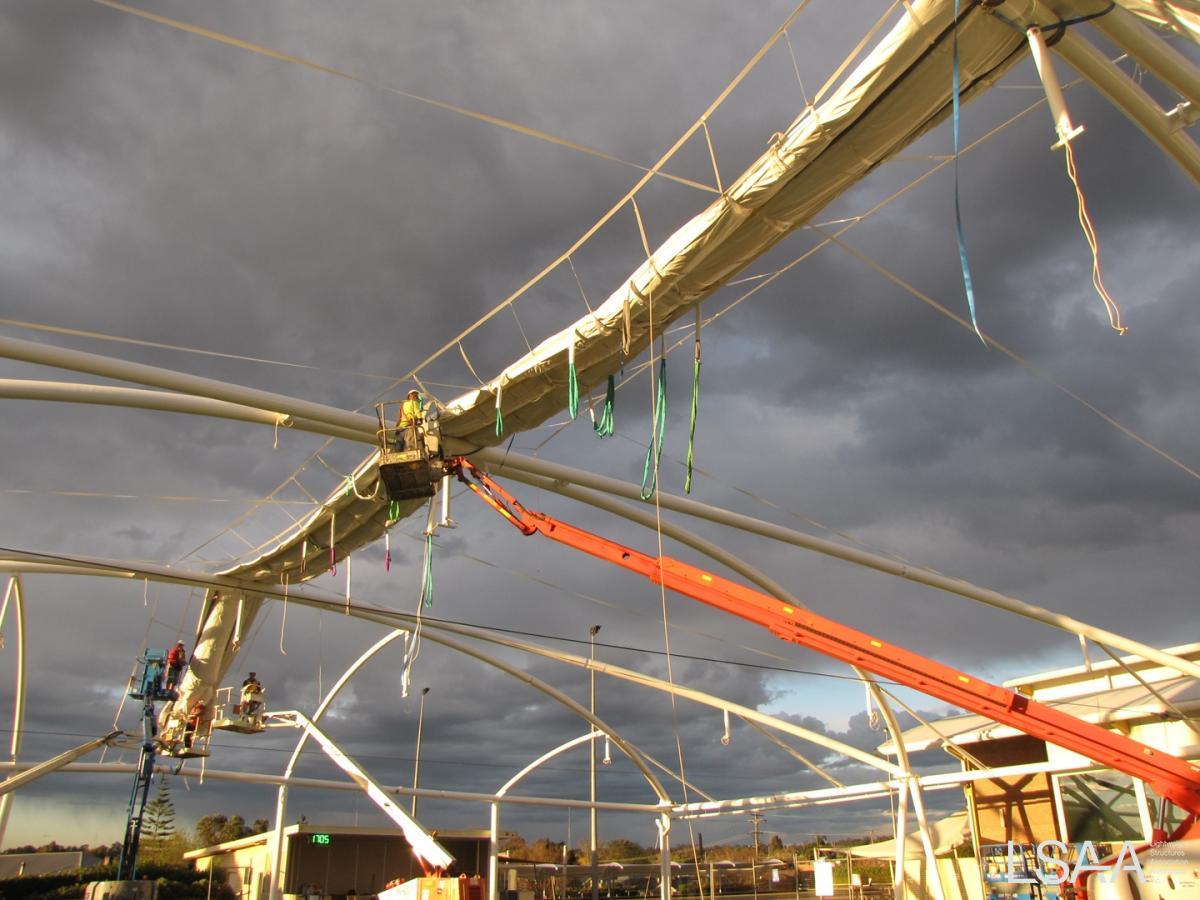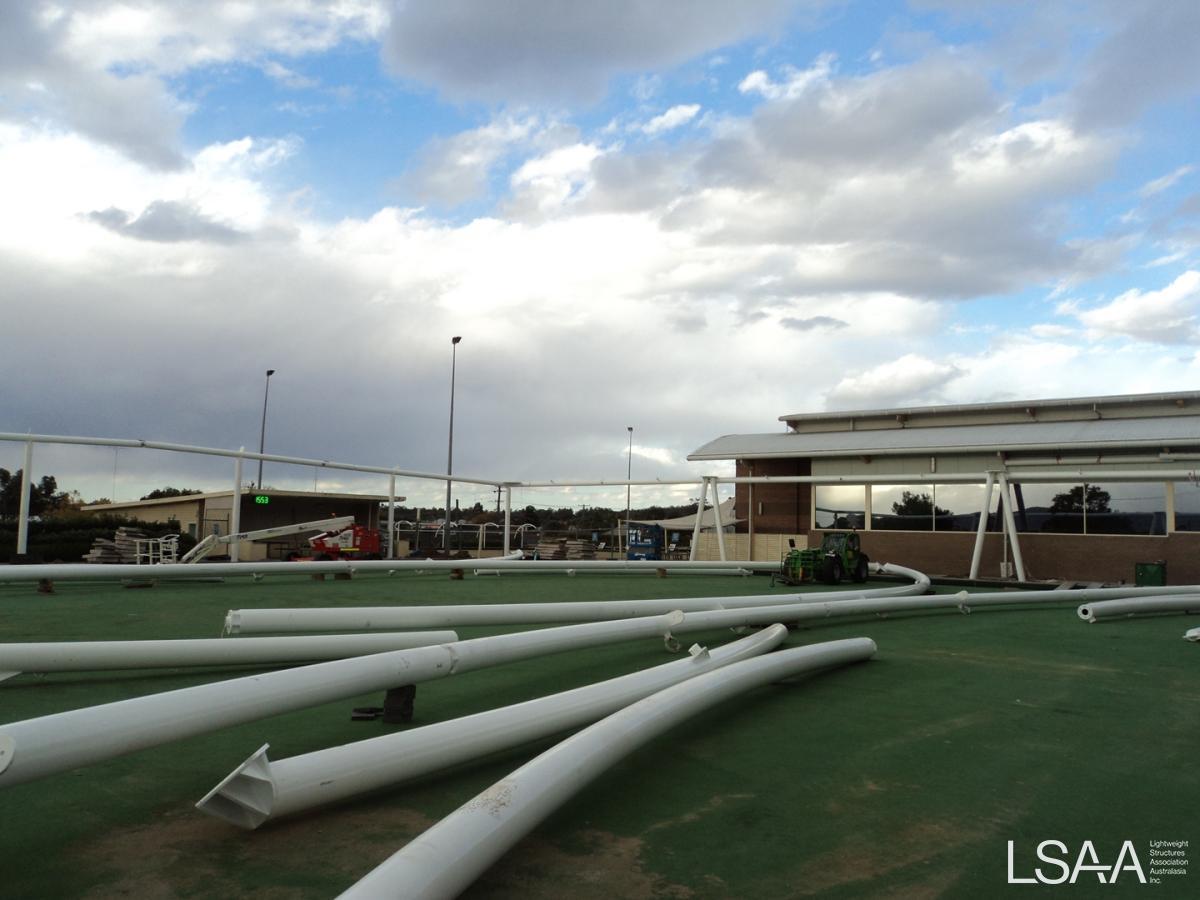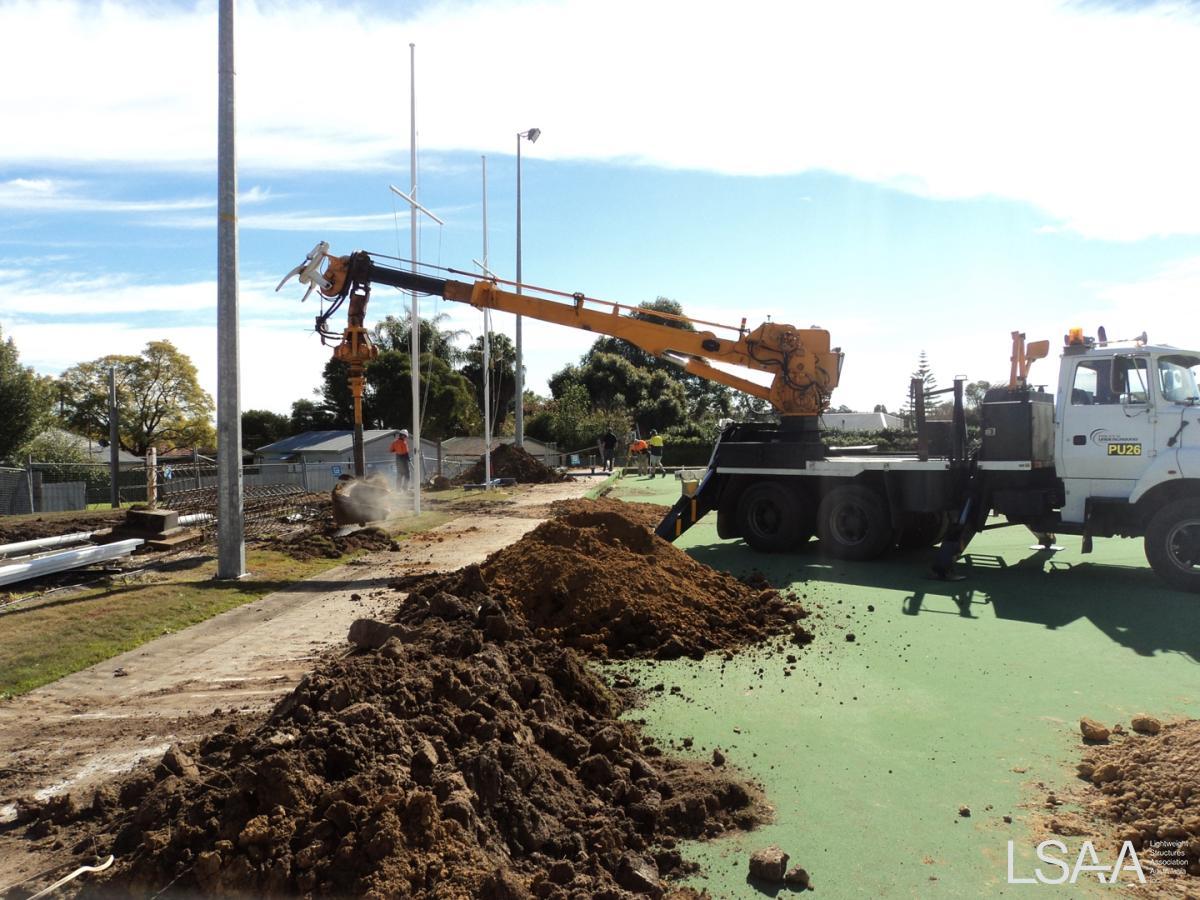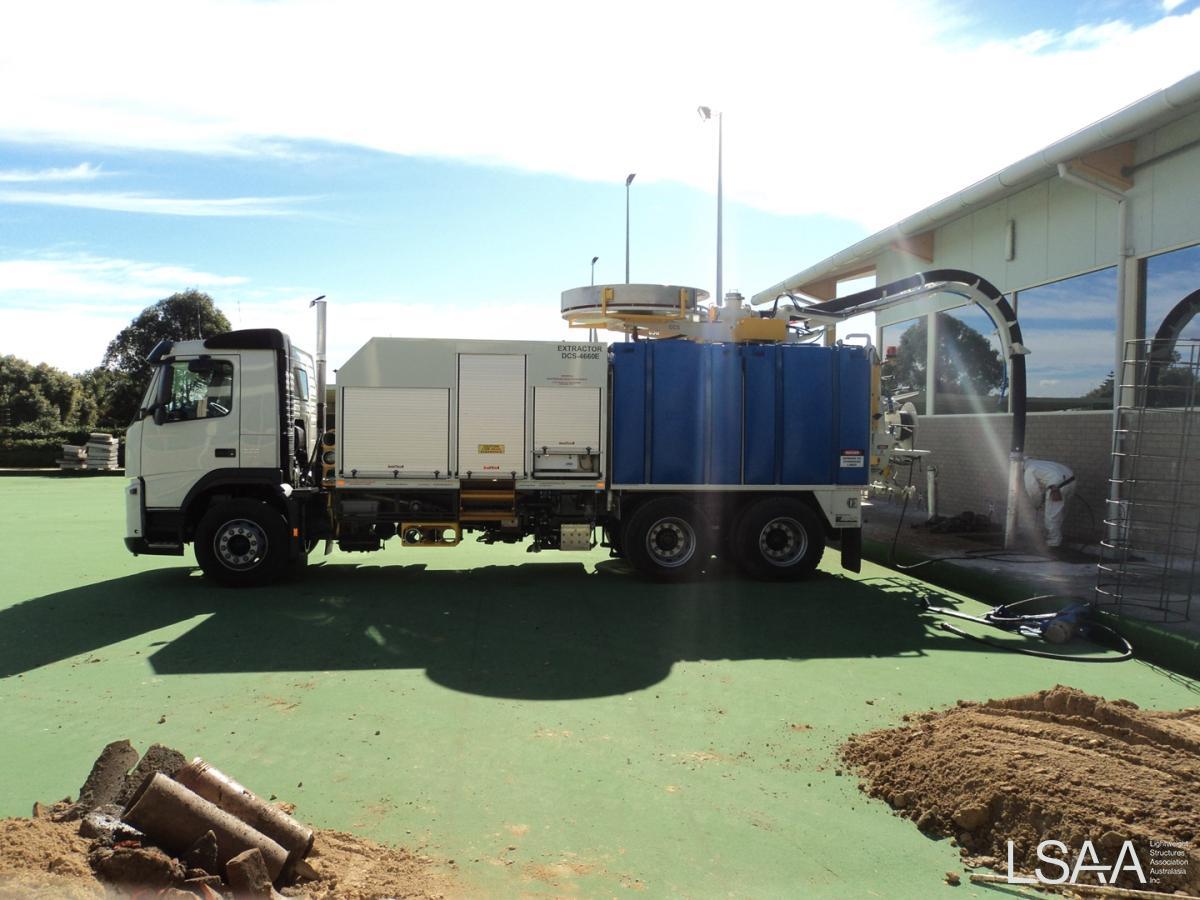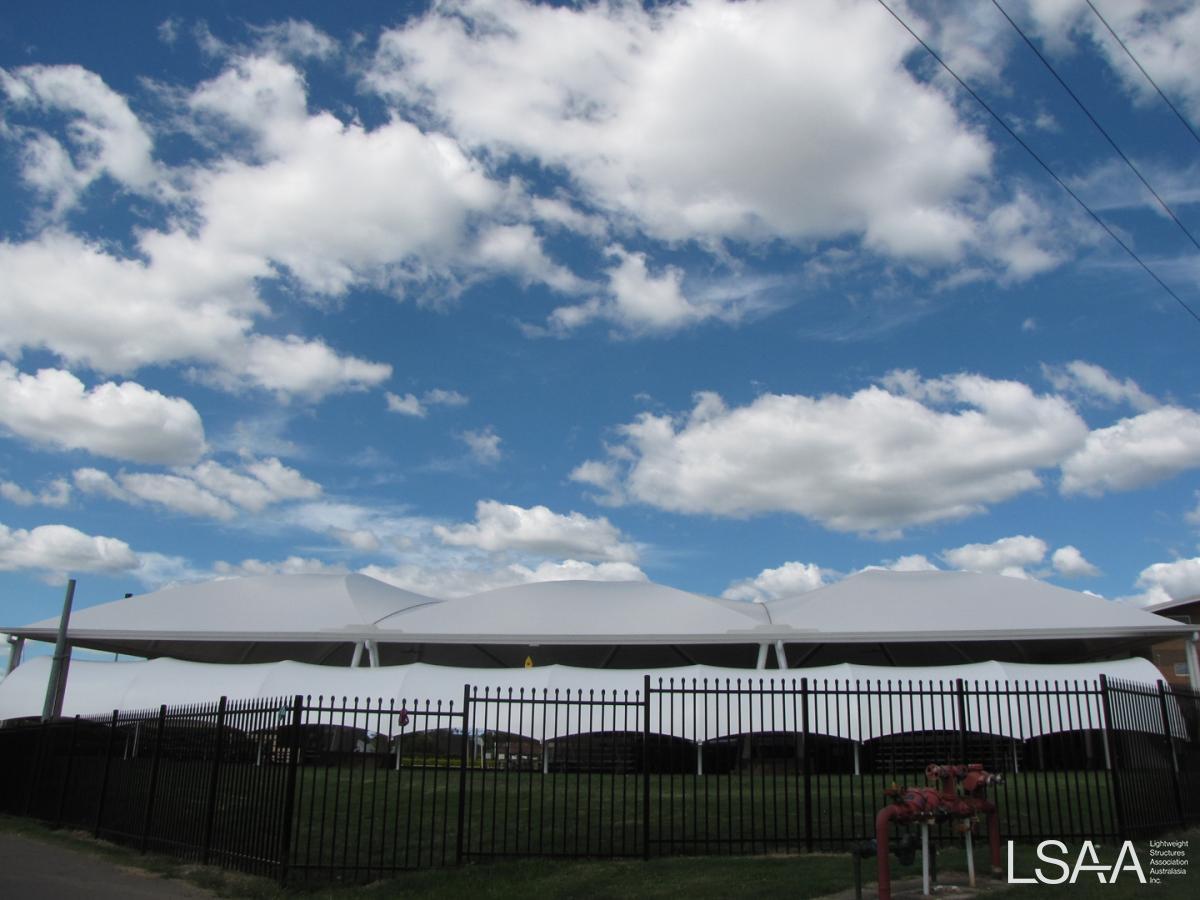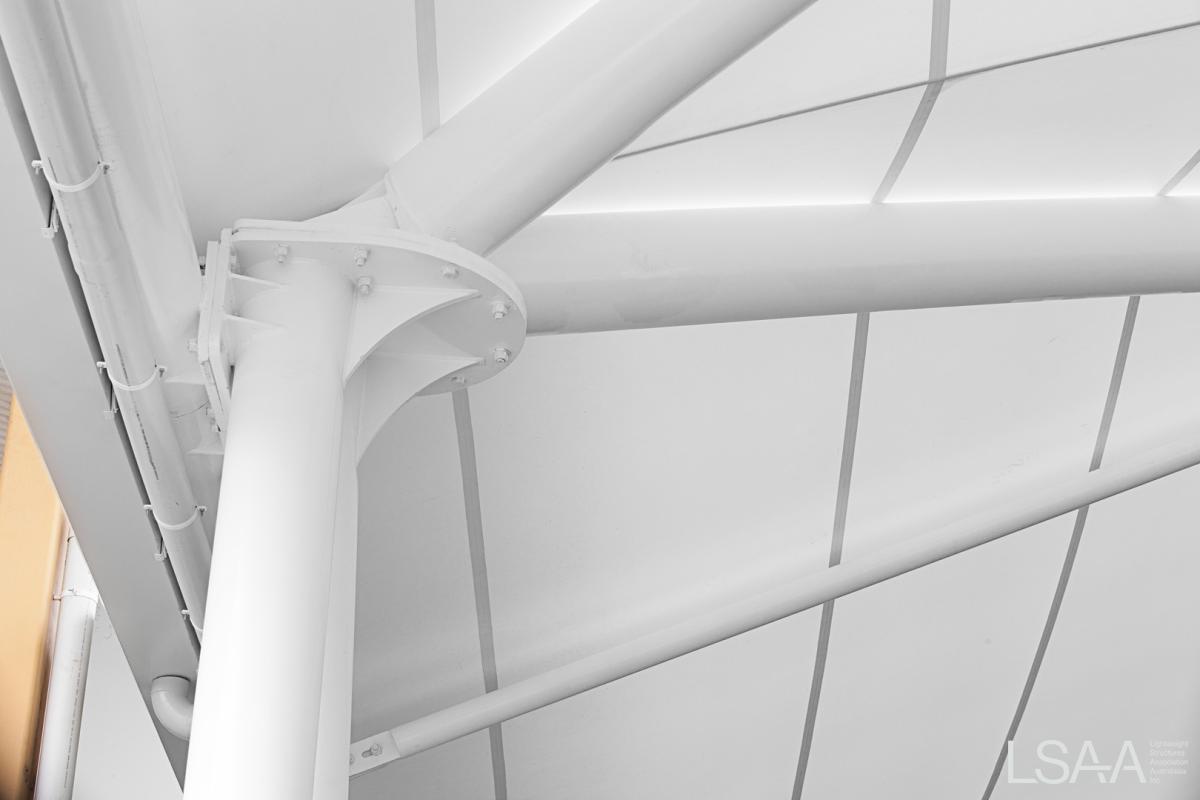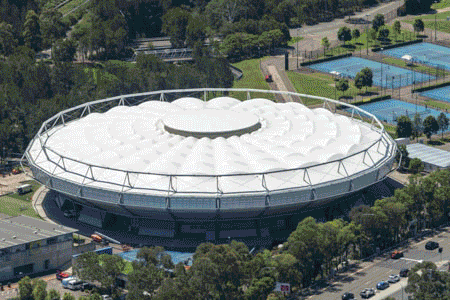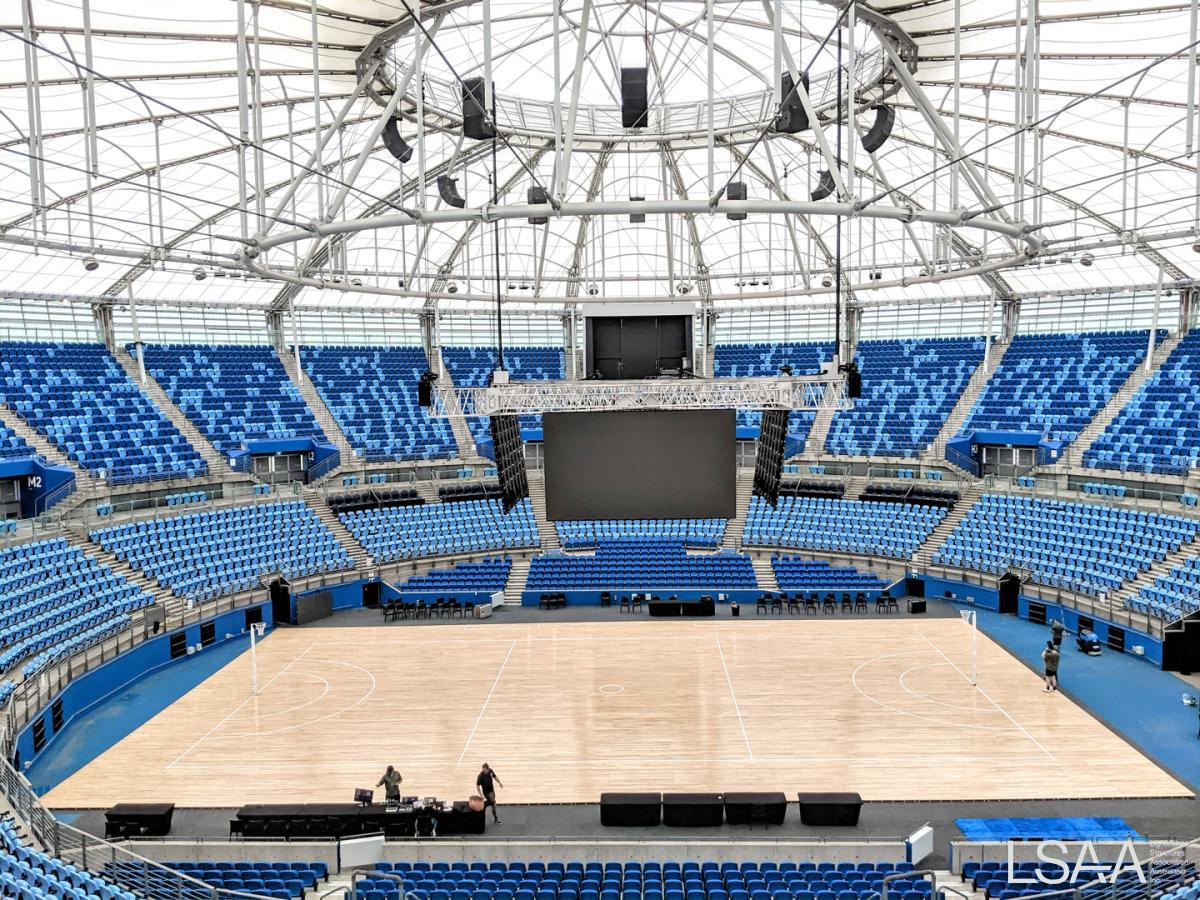This project was entered in the 2013 LSAA Design Awards (Large Structures, 4352)
East Cessnock Bowling Club
Entrant: Light Weight Structures
-
Location: Neath Street Cessnock NSW
-
Client: East Cessnock Bowls Club
-
Completion Date: September 2012
APPLICATION OF PROJECT:
The project covered one Bowling Green measuring 1820 sqmts. The project was designed to offer weather protection to bowlers, including night time use of the Bowling Green (in a residential setting) and minimal cleaning maintenance over the life of the structure.
The client requested that the project offered weather protection to bowlers and require low levels of cleaning maintenance. The club building was elevated and adjacent to the bowling green. Floor to ceiling glass in the Sportsman’s Bar and Restaurant offered panoramic views of the bowling green.
The club requested these views not be impeded. The Wide Span Structure was to integrate into the existing club building offering a weatherproof seal between the club building and the Wide Span Structure. Importantly, the club wanted to increase revenue by offering night time bowling to stimulate other income streams. As the club was positioned in a residential area complaints from neighbours had prevented the operation of night time lighting of the green. The structure was to encapsulate the artificial lighting so the greens could be used at night.
Fabric roofing was the superior choice of roofing material over conventional metal roofing, as fabric offers translucency of natural light during daylight hours and with the use of energy efficient up lights an aesthetically favorable backlit effect at night with the added benefit of shadow free reflected lighting to the bowling arena. The structural design features leaning arches and valley cables spanning the width of the structure forming a Ridge and Valley canopy. The ends of structure are curved/closed encapsulating artificial night time light within the roof canopy minimizing the night time light spillage and annoyance to neighbouring properties.
PROJECT DESCRIPTION:
Enclosing a single bowling green with our unique ridge and valley style structure is an innovative design developed by our company to offer weather protection over Bowling Greens .
Unconventionally, the striking beauty of this minimalist structure is held on the underbelly of the fabric canopy. Representing an authentic lightweight structure with a structural steel to surface area ratio of the fabric canopy at 20.15 kilograms per square meter of fabric and spanning a width of 44.3 mts and a length of 41.1 mts, the structure offers 1820 sqmts of clear-span space under canopy.
The structure has a maximum height of 9.94 mts, decreasing to a height of 4.1 mts along the perimeter. The north and south ends of the structure are designed with curved structural support to add stability to the fabric canopy with a low perimeter beam which provides much-needed protection from the hot summer sun and prevailing weather. Designed into the end (north and south) perimeter beam is a fall of 0.5 mts from the mid point to the end. This feature assists in water runoff in the perimeter guttering and minimizes the need for downpipes.
On the underside of the canopy large sections of heavy-duty pipe span the project width of 44.3 mts forming three sets of leaning arches. At a height of 9.94 mts, the fabric canopy appears to hug the leaning arch rafters positioned at 13.7 mt intervals. Adding contrast to the canopy’s form, cables tension the fabric between the leaning arches, creating a series of 1.3 mt deep valleys. This combination of leaning arch and valley cable creates an external ridge and valley effect when viewing the structure from the western side.
For night time use, the low perimeter frame encapsulates artificial light, up lighting and illuminating the canopy and reflecting shadow-free lighting down to the playing surface. Energy efficient lights are mounted on slender droppers from the leaning arches to a predetermined distance from the canopy surface to gain maximum reflective light. This feature utilizes the unique reflective nature of a fabric roof canopy. Externally, the northern end of the structure appears as a dome.
DESIGN / FABRICATION / INSTALLATION BRIEF
The project represents an authentic Light Weight Structure with the ratio of structural steel to surface area of the fabric canopy being 20.15 kg per sqmt of fabric.
The project was designed as an elegant means of offering maximum weather protection, night time lighting encapsulation and minimal cleaning maintenance within a set budget. The eastern and southern sides of the project were constructed in close proximity to the existing building offering a full weatherproof seal from the existing buildings to the structure. The northern end of the structure was designed with curved structural support to add stability to the curved fabric canopy. The low perimeter beam on the western side provides much needed protection from hot afternoon sun and prevailing weather conditions (wind and rain).
When developing the East Cessnock Bowling Club Structure it was determined the difficulty in engineering the structure lay in developing a means to span the 44.3 mts unsupported.
Rather than using trussed steel rafters, large diameter high strength pipe sections in a leaning arch configuration would create the required strength to span the 44.3 mt distance. These pipe sections maintain strength but are cost effective as they require minimal labor during fabrication. Valley cables over the top of the fabric canopy deliver both strength and stability to the fabric. In addition, the Valley cables allow for tensioning of the canopy if required after a severe storm event.
Along the 41.1 mt length of the structure an inverted vee column configuration has been utilized to offer longitudinal stability to the structure. On the northern and southern ends of the structure, straight columns have been utilized to minimize the disruptions to line of sight from the elevated Sportsman’s Bar. Strut members brace the 13.7 mt perimeter beam span between the inverted vee columns to the leaning arches minimizing deflection introduced into the perimeter beam by the tension of the fabric canopy.
The combination of leaning arches and valley cables resulted in less structural surface for dust, dirt and nesting birds to accumulate. Consequently less cleaning maintenance is required to keep the structure looking in optimum condition.
Visually the end result for the East Cessnock Bowling Club project is dramatic: clean elegant design lines, combined with an undulating fabric line and soaring height creating an open expanse that has transformed the once exposed site into an iconic landmark within the Hunter Valley region.
STRUCTURAL SYSTEMS
Our design engineer took into consideration the site orientation, prevailing weather direction and site location, when completing structural analysis for the project.
The design wind criteria for the site is Region A, terrain category 3 recurrence interval 1/500 design wind speed 37mps (strength) in accordance with AS1170.2-2002. The geotechnical report showed that the site soil type was stable. The main issue with the digging of foundations was the avoidance of underground services. The underground services locator nominated the foundations, which had the services running through the excavation area. These foundations were excavated utilizing a hydro excavator (vacuum extraction) to insure no damage to the underground services.
CFD software was used to assist with the design optimization of the fabric canopy. AS1170.2-2002 was used for determining Cp values for the ridge and valley fabric canopy profile.
MATERIALS
The project site boundary is 120 mts from a busy aerial road with heavy environmental pollution. Ferrari 1002T2 was chosen due to the fabric’s self-cleaning properties, 15 year warranty, ease of installation and cost effectiveness.
All structural members are grade 350 steel coated with Dulux Weathermax paint system for corrosion protection.
FABRICATION
The 1820 sqmt canopy was manufactured in one piece. The canopy was patterned in accordance with the stretch percentages obtained from biaxial test results of fabric samples taken from the fabric roles used for the project. The designer had to consider the fabric canopy manufacture and installation.
To streamline the installation process a folding plan was developed for the canopy to ensure the correct method of folding in the fabricators factory detailed planning at this stage, assisted the fabric installers and minimized onsite handling of the canopy and reduced installation time and crane hire time.
On site the hold down bolts were installed to a tolerance of 5mm spanning the project site width of 44.3 mts and length of 41.1 mts. The accuracy and positioning of the hold down bolts was achieved by engaging a site surveyor.
COLLABORATION, CONSTRUCTION AND MAINTENANCE
Timeline: A tight timeline governed the project; the client required the full facility to be ready for use by mid October 2012 as the clubs second grass green was due for refurbishment in spring, ready for the Summer bowling season. If the mid October deadline was exceeded the club would be without bowling greens until the covered structure was completed. After completion of the tensile canopy a new synthetic service was laid on the bowling green, which required between three to four weeks installation.
The project had a twenty-four week time line of which a nine-week delay was encountered with gaining DA approval from the local council. This delay placed added pressure on all fabricators both steel and fabric.
To maintain the structure in optimum condition including the structural steel (vee columns, perimeter beam and leaning arches) our company has put in place a maintenance program.
Completed in 2012 the Ferrari Fabric 1002T2 has performed well, as promised the fabric is self-cleaning during rain periods. There appears no reason to clean the fabric at this stage.
The structure was completed on time and on budget.
The contract was signed 4th April 2012.
Site installation work commenced 30th July 2012 – 3rd August 2012 for foundations.
Steel installation from 14th August 2012 – 22nd August 2012
Fabric installation from 30th August 2012 – 5th September 2012
Miscellaneous works 6th September 2012 -10th September 2012
The design submitted in this application is a copyright design developed in response to the Mooloolaba Bowls Club tender in May 2011 and reproduced by our company for the East Cessnock Bowling Club.
Credits:
-
Structural Engineer: Jeremy Hunter
-
Specialists: Trevor Scott Building Designer
-
Builder: Light Weight Structures
-
Fabricator: Stanfast
-
Installer: Light Weight Structures


